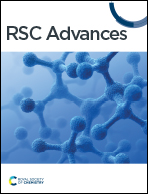Super-stable SnO2/MoS2 enhanced the electrocatalytic hydrogen evolution in acidic environments†
Abstract
For electrocatalytic hydrogen evolution in acidic environments, the stability of catalysts has always been a significant factor restricting development. Here, we prepared a superstable SnO2/MoS2 coupled nanosheet array on carbon cloth (CC@SnO2/MoS2), exhibiting an overpotential of 166 mV at a current density of 10 mA cm−2. According to the results of various tests and theoretical calculations, it is shown that the establishment of SnO2/MoS2 interface engineering is to accelerate the electron transmission on the heterogeneous interface and S defects on the edge of MoS2, and finally improve the conductivity and catalytic activity of the catalyst. More importantly, the formation of an SnO2 interface layer during in situ transformation improves the stability and hydrophilicity of the material surface. We have proposed a strategy for engineering an interface with fast electron transport and proton adsorption, providing some new ideas for the design of HER catalysts in acid electrolytes.



 Please wait while we load your content...
Please wait while we load your content...